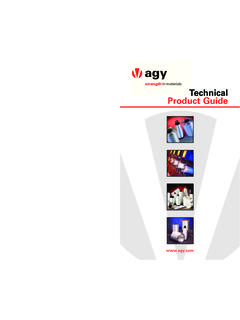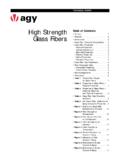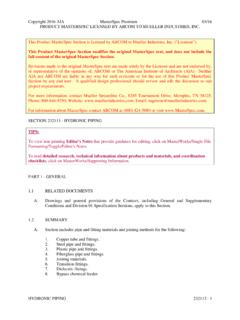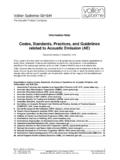Transcription of Technical Product Guide - AGY
1 TechnicalProduct in materials1 Corporate OverviewAGY provides the best quality, highest performance, and broadest range of glass fiber yarns, rovings and chop products to a wide variety of markets and end uses. Although founded as an independent entity in 1998, AGY has a 50+ year history of serving the composites industry. Globally, AGY has over 600 employees involved in production, sales, distribution and development of our products. Our world headquarters, technology center and manufacturing facility are located in Aiken, SC We also have commercial and administrative offices in Lyon, France, and a commercial office in Shanghai, of ContentsCorporate Overview ..1 Glass Fiber Manufacturing.
2 2 Nomenclature ..3 Conversion Tables ..6 AGY Glass Yarns ..8 AGY Glass Rovings ..14 AGY Chopped Glass ..16 AGY Packaging Specificaions ..18 AGY Sizing Systems ..20 Typical Fiber Properties ..26 Glossary of Terms ..28strength in materialsGlass Fiber ManufacturingAGY glass fibers are made from molten glass. The viscous liquid is drawn through tiny holes at the base of the furnace to form hair-like filaments . A protective sizing, applied as the filament cools and hardens, helps prevent abrasion during additional processing and makes the glass compatible with various resin yarn products, after sizing is applied, filaments are gathered into strands and wound into intermediate (forming) packages for processing.
3 These strands become the basic components for a variety of textile and roving yarns are produced by twisting and sometimes plying several strands of fiber. Once twisted, the yarns can be further processed by beaming or rewinding onto different yarns can also be texturized for decorative and industrial applications and coated with a variety of resinous or elastomeric materials. For some processes, the gathered strands are not wound onto packages but are further processed into chopped strands for a variety of Material StorageFurnaceBinder ApplicationVarious Yarn bobbinsForming PackageTwistingBushingTexturizingAir JetChopAssembled rovingSingle End RovingBeamsOven3 Glass Fiber Nomenclature GeneralGlass fiber yarns are typically identified by either an inch-pound based system ( customary system) or a TEX/metric system (based on the SI*/metric system).
4 This section gives a brief description of glass fiber yarn nomenclature, including comparisons of the two systems (see table on page 4). A more comprehensive description can be found in ASTM D578 standard specification for glass fiber s products use standardized nomenclature designations that include both alphabetical and numerical elements. They identify glass composition, filament type, strand count and yarn construction. These designations match either an inch-pound version or a TEX/metric version. Both systems are industry-recognized NomenclatureGlass fiber roving nomenclature is defined by ASTM D578. The nomenclature uses alpha-numeric designations signifying binder, sizing, yield in yards and method of manufacture/construction of a roving.
5 The following is an explanation of the standard alpha-numerical form: XXXX-YY-ZZZZ. XXXX is a number/character combination signifying a binder (sizing). Typically it is a three-digit number with or without a letter designation afterwards. YY is a two-character alpha (letter) designation used internally by AGY to identify the method of manufacture or construction of a roving, for example it may be an assemblage of multiple ends of a G75 yarn to produce a given yield. The letters would change as the method of production changed. Note that each company producing glass fiber rovings use their own letter designations so they would not be comparable for similar products from different manufacturers.
6 Because of this, roving nomenclature is often shortened to indicate only the sizing and the yield as in 449-750, dropping the two-letter middle designator. ZZZZ at the end of the form is the yield in yards/lb for customary system (or TEX for the SI/metric system), typically rounded to the nearest conventional yield ( , AGY s 449-AA-750 yield rovings are actually 735 nominal). Designations such as 250, 750 and 1250 have been in existence for years, and it has become convention to use them instead of actual nominals. Please refer to the appropriate Product Technical specification for actual yields of a given NomenclatureGlass fiber chop nomenclature is defined by ASTM D578.
7 The chop nomenclature is modelled after the yarn nomenclature, and has the basic form: SG37 544 5/32 INCH 2204 LB BULK BAGW hereS = Glass type, and can be E, S, L etcG = Filament filameter (See Table 1)37 = chop bundle size, in this case it was chopped from a 3700 yd / lb input 544 = Binder system5/32 inch = chop length2204 lb bulk bag = packaging *Le Syst me International d Unit s (SI)4 Yarn NomenclaureTypical Yarn Nomenclature Identified in Customary System (based on inch-pound) Glass Composition: E=Electrical L=Low Dieletric S=High Strength Type of Filament: C=Continuous S=Staple T=Texturized Filament Diameter: (see Table 1) Yield Designation: (see Table 2) Number of single strands twisted into continuous filament ends/Number of twisted strands plied together Number of turns per inch in The twist of the final yarn Direction of twist S = S direction Z = Z direction (see next page) The example above then identifies the Following yarn: ECG75 1/2 E = electrical glass C = continuous filament G = average filament diameter (see table 1) 75 = 7,500 yards/lb.
8 Nominal bare glass in basic strand 1/2 = one ply of 2-strand construction (total 2 basic strands) = the number of turns per inch (TPI) in the twist of the final yarn S = the direction of the twistTypical Yarn Nomenclature Identified In TEX/Metric System (based on SI/metric) Glass Composition: E=Electrical L=Low Dieletric S=High Strength Type of Filament: C=Continuous S=Staple T=Texturized Filament Diameter: (see Table 1) Yield Designation: (see Table 2) Number of single strands twisted into continuous filament ends x Number of twisted strands plied together Direction of twist S = S direction Z = Z direction (see next page) Number of turns per meter in the twist of the final yarn The example above then identifies the Following yarn.
9 EC9 68 1x2 S112 E = electrical glass C = continuous filament 9 = 9 micrometers 68 = 68 grams per 1,000 meters of yarn 1x2 = one ply of 2-strand construction (total 2 basic strands) S = the direction of the twist 112 = the number of turns per meter (TPM) in the twist of the final yarnEECCG975681 fifth segment in the nomenclature is the number of basic strands* twisted together intp a single yarn. Following this number is the number of turns per unit length and either the letter S or Z which indicates the direction of the twist. The S or Z direction of the yarn is determined by the slope of the yarn when it is held in a vertical position. A twist is mechanically applied to yarns because, in addition to helping keep all of the filaments together, it provides the yarn higher abrasion resistance, improved processing and better tensile Customary YieldThe approximate length of the fabricated yarn required to make one pound mass can be computed when the yield designation number is multiplied by 100 and divided by the total number of strands.
10 The result of this computation must always be considered approximate. The yards per pound are reduced slightly in the twisting and plying operations, and by the addition of sizes or binders. *A basic strand is one produced from a single twist: ascending left to right configuration as in center of letter Z6 Filament DesignationsRange for filament Diameter AverageUS Units (letter)SI Units (microns) DesignationsNominal Yarn Number (strand count)US Units(letter)SI Units(microns)100yds/lbBare Glass(yds/lb)SI Units TEX(g/1000m)Approximate Number ofFilamentsBC4 3,750 375,000 3,400 340,000 3,000 300,000 2,250 225,000 1,500 150,000 1,800 180,000 1,700 170,000 1,360 136,000 1,200 120,000 1,020 102,000 900 90,000 510 51,000 450 45,000 11204DE6 340 34,000 15200E7 255 22,500 22200E7 225 22,500 22204BC4 150 15,000 331064DE6 150 15,000 33408G9 150 15,000 33204DE6 100 10,000 50612DE6 75 7,500 66816G9 75 7,500 66408H11 55 5,500 90408G9 50 5,000 99609G9 37 3,700 134816K13 37 3,700 134408H11 25 2,500 198816G9 19 1,900 2571632K13 18 1,800 275816H11 18 1.






